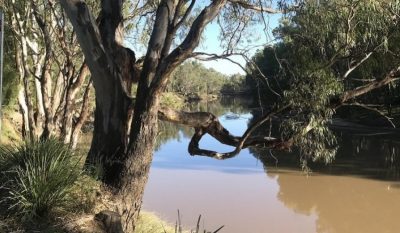Australia: Colonialism Continues with First Nations’ Water Dispossession

All Global Research articles can be read in 27 languages by activating the “Translate Website” drop down menu on the top banner of our home page (Desktop version).
***
The ongoing injustices and dispossession of First Nations peoples can be seen in the devastating impact of stolen water rights.
A 2020 report from Griffith University researchers on the diminishing water rights of Traditional Owners of the rivers which make up the Murray Darling Basin confirms the extent of First Nation’s dispossession.
Trends in Aborginal water ownership in New South Wales, Australia: The continuities between colonial and neoliberal forms of dispossession details how reduced access to safe drinking water has led to difficulty in maintaining cultural practices which have helped devastate riverine environments and wetlands.
Across 10 catchments in the New South Wales portion of the Murray-Darling Basin, Aboriginal people make up almost 10% of the population. Collectively, however, they have access to just 12.1 gigalitres of water — 0.2% of all available surface water.
The population of First Nations peoples is predicted to rise to 15%, which the authors say will worsen water dispossession.
The Griffith study found that the value of water held by Aboriginal organisations was $16.5 million (over 2015–16), just 0.1% of the value of the Murray-Darling Basin’s water market.
From 2009–2018, water rights held by Aboriginal people in the Murray-Darling Basin in New South Wales shrunk by at least 17.2%, or 2 gigalitres of water per year. No new entitlements were acquired over the decade.
The federal government has set aside $40 million to buy water back for Aboriginal organisations but, so far, this has not happened. In a drastically over-allocated free market water allocation system, this is unlikely to be anything more than token.
However, last November the Victorian government announced a landmark reallocation of 2 gigalitres of water outside of the Murray Darling Basin on the Mitchell River to the Gunaikurnai Land and Waters Aboriginal Corporation.
Improvements in water management in the Gippsland region have led to unallocated water being returned to First Nations peoples for cultural, environmental and economic purposes. Aboriginal Water Rights advocate Will Mooney said the Gunaikurnai water grant showed the state government recognised First Nations’ “inherent rights” and that “water justice needs to involve that transfer of water back”.
But Troy McDonald, a spokesperson for the Gunaikurnai Land and Waters Aboriginal Corporation (GLaWAC), cautioned about the barriers that remain for Traditional Owners in their allocation of water. Writing for the November 20 The Conversation, McDonald said: “Victoria’s water entitlement framework is consumption-based — it is designed for water to be taken out of rivers, not left in.
“This can make it hard for Traditional Owners to leave water in the river for the benefit of the environment. So water entitlements and rules should be changed to reflect how traditional owners want to manage water.”
GLaWAC want water recovery reforms to cover fees and charges, which can run into tens of thousands of dollars each year.
Land rights and Native Title claims awarded to Traditional Owners in other states have excluded rights to water.
When the Barkandji of the Barwon Barka Darling Rivers won their title, after 18 years of legal battle in 2015, it came with no water, wetlands or riverine environments. These ecosystems have since all collapsed, with devastating impacts.
The Traditional Owners of Lake Victoria, near the South Australian border, have been pushing for compensation for the land and water that have been taken from them.
Murra Wurra Paakintji elder Dorothy Lawson is using laws that led to her people’s dispossession to make the claim under the Nullum Tempus Act and the principle of adverse possession for the lake where her people once lived.
Lawson said her great-grandfather, Dan McGregor, along with his Maraura contemporaries, obtained the possessory title of their homeland in western NSW in 1848, having lived there, uninterruptedly, for 60 years since the British colony was set up.
In 1922, NSW allowed SA to take charge of Lake Victoria, and use it for water storage. Three judges of the NSW Court of Appeal have now ruled that any rights Lawson held over that land were converted into a claim for compensation under the Public Works Act when SA assumed management of the lake.
It remains to be seen whether the SA Water Minister and NSW solicitors will appeal that decision in the High Court. The case is currently listed for the Land and Environment Court.
The Murray-Darling Basin Plan included detailed rules for how states must engage with the views of First Nations peoples.
But, until last year, no Aboriginal representative had been appointed to the Murray-Darling Basin Authority Board. Nari Nari man Rene Woods, former CEO of Murray Lower Darling Rivers Indigenous Nations, was finally appointed in November.
Following the litany of errors leading up to, and since, the fish kills on the Darling River, the NSW government is finally being dragged to the table.
Murray Lower Darling Rivers Indigenous Nations spokesperson Will Mooney told Green Left:
“They have had to recognise that there was a complete absence of recognition of First Nations’ water rights and that the public discussion has moved forward so much [showing] that their policy framework was seriously deficient.
“We need much stronger commitments and actions to recognise cultural flows, First Nations Rights to access water and their right to have a really strong role in water management.”
*
Note to readers: please click the share buttons above or below. Forward this article to your email lists. Crosspost on your blog site, internet forums. etc.
Featured image: Murrumbidgee River. Photo: Tracey Carpenter

